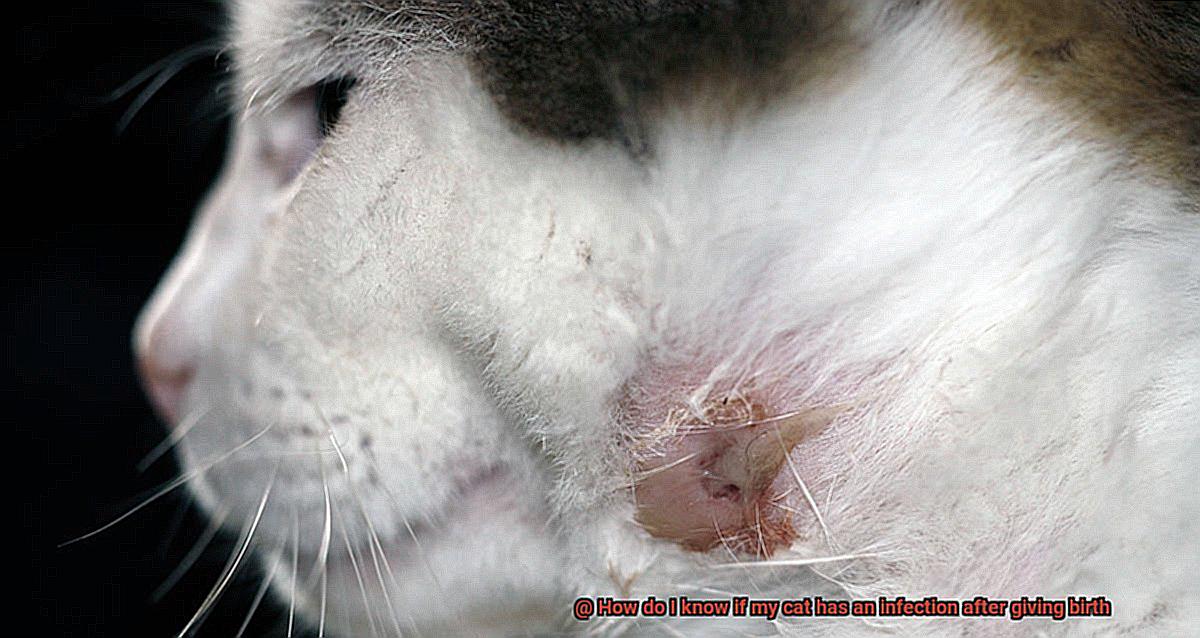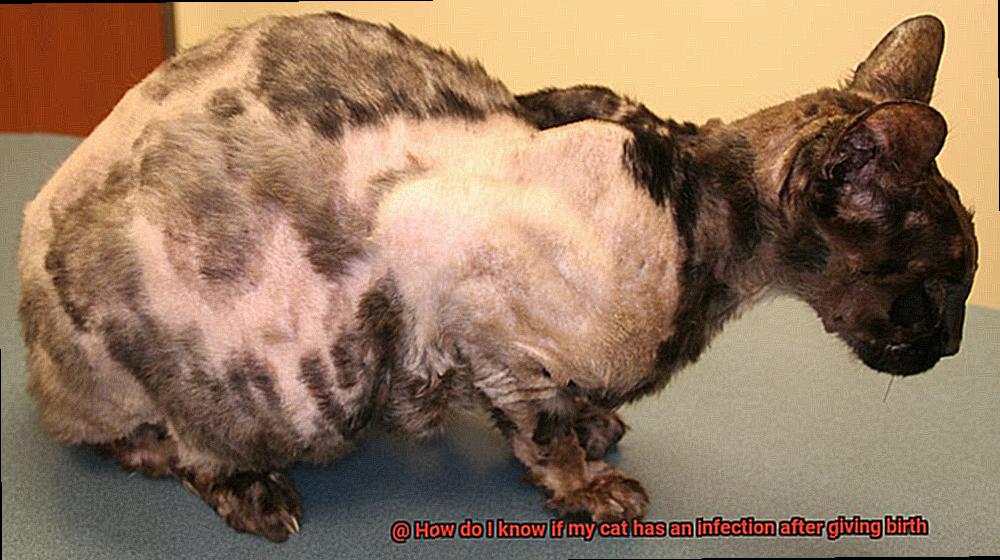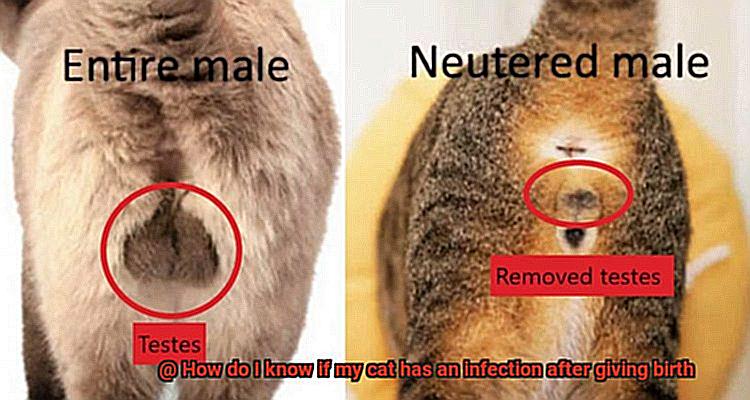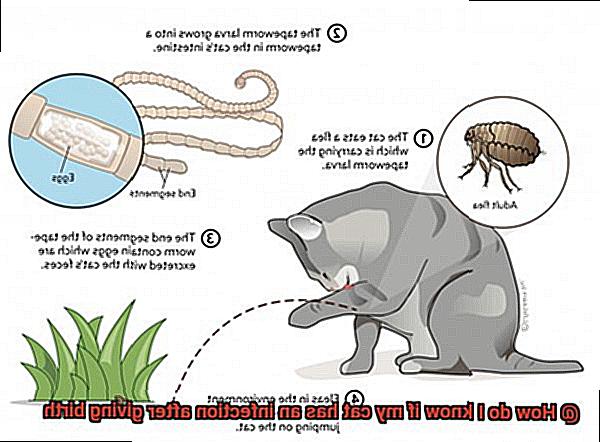Cats are known for their adorable kittens, but giving birth can be an exhausting process for mother cats. If they experience complications during delivery, it can be even more challenging. As a pet owner, it’s crucial to keep a close eye on your cat to ensure her health and safety after giving birth.
One of the most common concerns is how to tell if your cat has an infection after giving birth. Infections can occur due to dirty birthing conditions, untreated injuries, or hormonal and physiological changes that come with pregnancy and delivery. These infections can be life-threatening and detrimental to your cat’s health.
In this blog post, we’ll discuss everything you need to know about identifying and treating infections in cats after giving birth. From understanding the causes and symptoms of infections to knowing how to prevent them from happening, we’ll cover it all. Whether you’re a seasoned cat owner or planning to adopt a furry friend in the future, this post will provide valuable insights that will help keep your cat healthy and happy after birth.

Common Signs of Infection: What are the most common symptoms of infection?
Infections can result from multiple factors, such as complications during labor, unsanitary conditions, or a weakened immune system. Therefore, it’s essential to closely monitor your cat’s health and wellbeing to prevent any potential infections.
The most common symptoms of infection in cats after giving birth include fever, lethargy, loss of appetite, discharge from the vulva, foul-smelling discharge, and swollen or red mammary glands. If you observe any of these symptoms in your cat, don’t hesitate to contact your veterinarian immediately. They will conduct a thorough physical examination and may recommend diagnostic tests to determine the type and severity of the infection.
Apart from physical symptoms, it’s also crucial to pay attention to changes in your cat’s behavior. If she appears more irritable than usual or is avoiding contact with her kittens, this could be a sign of an infection. Additionally, some cats may not show any obvious signs of infection, especially in its early stages.
To prevent further infection, ensure that your cat’s surroundings are clean and hygienic. Regularly cleaning her bedding and litter box and providing clean water and nutrient-rich food will help her recover more quickly.

Diagnosis: How does a veterinarian determine if your cat has an infection?
However, it’s crucial to keep a watchful eye on your furry friend after she gives birth to prevent any possible infections that can arise from complications during labor, unsanitary conditions, or a weakened immune system. If you suspect that your cat may have an infection after giving birth, it’s essential to seek veterinary care as soon as possible.
But how do veterinarians determine if your cat has an infection? Well, there are several tests that they may perform to evaluate your cat’s health and diagnose any infections.
To start with, a complete blood count (CBC) test can help identify if there is an increase in white blood cells, which is a tell-tale sign of an infection. Additionally, veterinarians may perform a blood chemistry panel to assess the cat’s kidney and liver function, which can be compromised by infections.
Another test that may be conducted is a bacterial culture. This involves taking a sample of the discharge or fluid from the cat’s uterus and growing it in a lab to determine the type of bacteria present. This information helps determine the most effective treatment for the infection.
In some cases, imaging tests such as x-rays or ultrasounds may also be recommended to evaluate the extent of the infection and identify any complications such as retained placenta.
It’s important to remember that early detection and treatment of infections after giving birth are critical for the health and wellbeing of both the mother cat and her kittens. Therefore, if you notice any signs of infection such as fever, lethargy, loss of appetite or discharge from the vagina, it’s vital to seek veterinary care immediately.
Treatment of Infection: What medications or treatments may be prescribed for an infection?
However, infections can occur in cats after giving birth, which can lead to serious health complications if left untreated. That’s why it’s crucial to seek veterinary care immediately if you suspect an infection.
Your vet will likely prescribe antibiotics as the first line of defense against bacterial infections in cats. These antibiotics may be broad-spectrum, targeting a wide range of bacteria, or specific to the type of bacteria causing the infection. It is crucial to follow your vet’s instructions carefully when administering antibiotics to avoid antibiotic resistance and recurring infections.
In addition to antibiotics, anti-inflammatory drugs may also be prescribed to reduce inflammation and pain caused by the infection. These drugs can bring much-needed relief to your cat, especially in cases where the infection has spread and is causing discomfort. Wound care, such as cleaning and dressing any infected wounds, may also be necessary.
Moreover, supportive care measures such as fluid therapy may be recommended to help your cat stay hydrated and comfortable during recovery. This will ensure that your furry friend can bounce back from the infection quickly and regain her strength.
Remember that early detection and prompt veterinary care are key to successfully treating infections in cats after giving birth. Keep an eye out for any signs of infection in your cat, such as fever, lethargy, discharge or swelling around the vaginal area, or difficulty nursing her kittens. If you notice any of these symptoms, don’t hesitate to seek veterinary attention right away.

Prevention of Infection: How can you prevent further infections from occurring?
However, it’s important to remember that infections can pose a significant risk to both the mother and her newborn kittens. To keep them healthy and happy, it’s crucial to take steps to prevent further infections from occurring. In this article, we’ll dive into how proper hygiene, monitoring for signs of infection, providing proper nutrition and hydration, limiting contact with other animals, and limiting human contact with newborn kittens can help prevent infections in cats after giving birth.

To start, maintaining proper hygiene is essential in preventing infections. Keeping the mother and her kittens in a clean environment is key, which means changing their bedding regularly and using disinfectant solutions to clean surfaces like litter boxes or feeding bowls. By doing so, you can reduce the risk of infection-causing bacteria spreading.
It’s also important to be vigilant for any signs of infection in the mother. Watch for symptoms such as fever, loss of appetite, or discharge from the vagina. If you notice any of these symptoms, seek immediate veterinary attention. Your veterinarian may prescribe antibiotics or other medications to treat the infection.
Proper nutrition and hydration are also critical during this time. As the mother will require more food and water than usual during lactation, make sure she has access to clean water at all times and feed her high-quality cat food specifically designed for nursing mothers. A well-nourished mother will be better equipped to fight off potential infections.
Another step in preventing infections is limiting contact between the mother and other animals. This helps prevent the spread of potential infections from other animals. It’s also wise to limit human contact with newborn kittens until they are a few weeks old as human hands can carry bacteria that may be harmful to them.
Cleanliness Is Key: How should you keep your cat’s environment clean and sanitary?
Bringing new life into the world is a joyous occasion, but it calls for some extra effort to maintain a clean and healthy environment for your cat and her kittens. The following tips will guide you on how to keep your cat’s surroundings clean and hygienic.
To begin with, cleaning the area where your cat gave birth is critical. It would be best to do this as soon as possible to reduce the risk of infection and ensure that the kittens have a safe and healthy living space. You can use warm soapy water or a pet-safe disinfectant to thoroughly clean the area.
Regularly cleaning your cat’s litter box is also vital. Accumulated waste can harbor harmful bacteria that could lead to infections. Daily scooping of waste and complete litter replacement every few days is recommended. Unscented, clumping litter is easier to clean and better for your cat’s health.
It’s essential to wash your cat’s bedding and any other items they come into contact with regularly. Use pet-safe detergent and hot water to get rid of any harmful substances that could accumulate in their environment. Avoid using harsh chemicals or strong fragrances as cats have an excellent sense of smell.
Lastly, keep an eye on your cat’s overall health after giving birth. If you notice any signs of infection, like discharge or swelling, take your cat to the vet as soon as possible. Proper care and attention will help ensure that your cat and her kittens stay healthy and happy.
Monitoring Your Cat’s Health: What steps should you take to ensure that your cat stays healthy after delivery?
Bringing new life into the world is a beautiful experience, but it also comes with a great responsibility. As a proud cat owner, your feline friend’s health and well-being should be at the top of your priority list, especially after delivery. To ensure that your cat stays healthy, it’s crucial to monitor her closely and take necessary steps.
One of the most crucial things to watch out for is signs of infection. After delivery, open wounds in the uterus and vagina can make your cat more susceptible to infections. Therefore, it’s essential to keep an eye on her behavior. If your cat seems lethargic, has a decreased appetite, or isn’t producing milk for her kittens, these may indicate an infection. Additionally, if you notice any foul-smelling discharge from her vagina or if it has a yellow or green color, it could also be an indication of infection.
To monitor your cat’s health, regularly check her temperature. A normal temperature for a cat is around 100-102.5°F. However, if her temperature rises above 103°F, it could be an indication of infection. Remember that taking a cat’s temperature can be tricky and should only be done by someone who knows how to do it safely.
If you suspect that your cat has an infection after giving birth, don’t hesitate to take her to the vet immediately. Infections can quickly become serious and even life-threatening if left untreated. Your vet will be able to diagnose the infection and provide appropriate treatment, which may include antibiotics and other medications.
Apart from monitoring signs of infection, providing proper nutrition and hydration for your cat is vital after giving birth. Make sure she has access to plenty of fresh water and high-quality food rich in nutrients. You may also want to supplement her diet with vitamins and minerals specifically designed for nursing cats.
f2WVdt4ndyA” >
Conclusion
To sum up, it’s crucial for cat owners to keep a watchful eye on their feline friend’s health after giving birth. Infections can happen due to a variety of reasons, like unhygienic conditions or complications during delivery. As a responsible pet owner, you should be aware of the common signs of infection in cats: fever, lethargy, loss of appetite, discharge from the vulva, foul-smelling discharge, and swollen or red mammary glands.
If you suspect your cat is suffering from an infection after giving birth, don’t hesitate to seek veterinary care immediately. Your vet may perform diagnostic tests like a complete blood count (CBC) or bacterial culture to determine the type and severity of the infection.
Treatment for infections in cats after giving birth usually involves antibiotics and anti-inflammatory drugs. Wound care and supportive measures such as fluid therapy may also be necessary.
To prevent future infections in your cat after giving birth, make sure you maintain proper hygiene by cleaning her surroundings regularly and limiting contact with other animals. Adequate nutrition and hydration are also essential during this time to help your cat recover quickly.
In short, keeping a close eye on your cat’s health after giving birth and seeking prompt veterinary attention if needed is vital for her wellbeing.







